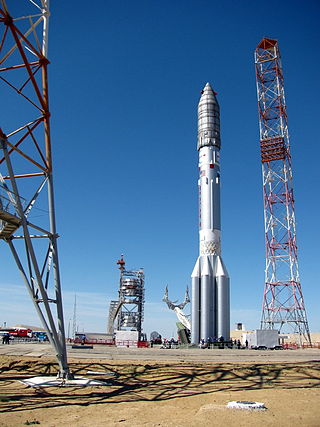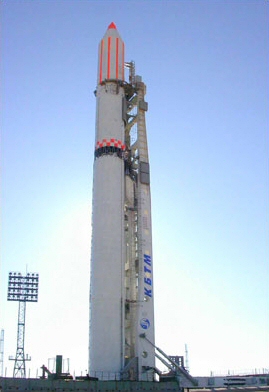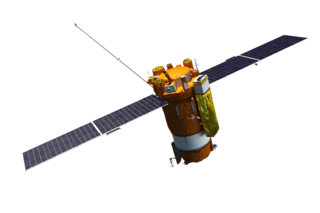Related Research Articles

GLONASS is a Russian satellite navigation system operating as part of a radionavigation-satellite service. It provides an alternative to Global Positioning System (GPS) and is the second navigational system in operation with global coverage and of comparable precision.

Milstar is a constellation of military communications satellites in geosynchronous orbit, which are operated by the United States Space Force, and provide secure and jam-resistant worldwide communications to meet the requirements of the Armed Forces of the United States. Six spacecraft were launched between 1994 and 2003, of which only five were operational after launch; the third launch failed, both damaging the satellite and leaving it in an unusable orbit.

Soyuz 2 is a modernized expendable medium-lift launch vehicle and the seventh major version of the Soyuz rocket family. It includes key enhancements over its predecessors including improved engines along with digital flight control and telemetry systems, enabling launches from fixed platforms and the use of large payload fairings.

The Proton-M, (Протон-М) GRAU index 8K82M or 8K82KM, is an expendable Russian heavy-lift launch vehicle derived from the Soviet-developed Proton. It is built by Khrunichev, and launched from sites 81 and 200 at the Baikonur Cosmodrome in Kazakhstan. Commercial launches are marketed by International Launch Services (ILS), and generally use Site 200/39. The first Proton-M launch occurred on 7 April 2001.

The Badr-B was the second spacecraft and the first Earth observation satellite launched into Sun-synchronous orbit on 10 December 2001 at 09:15 by SUPARCO — Pakistan's national space agency. Badr-B was a microsatellite, weighing approximately 70 kg, and contained a computerized system to conduct studies on gravity gradients. Badr-B was a research satellite to explore the upper atmosphere and the near space, carrying a large array of instruments for geophysical research.

GLONASS-K is the latest satellite design intended as a part of the Russian GLONASS radio-based satellite navigation system. Developed by ISS Reshetnev and first launched on 26 February 2011, it is a substantial improvement of the previous GLONASS-M second-generation satellites, having a longer lifespan and better accuracy.

Koronas-Foton, also known as CORONAS-Photon, was a Russian solar research satellite. It was the third satellite in the Russian Coronas programme, and part of the international Living With a Star programme. It was launched on 30 January 2009, from Site 32/2 at the Plesetsk Cosmodrome, aboard the final flight of the Tsyklon-3 rocket. On 1 December 2009 all scientific instruments on the satellite were turned off due to the problems with power supply that were caused by a design flaw. On 18 April 2010 the creators of the satellite announced it was lost "with a good deal of certainty".
Meridian 2, also known as Meridian No.12L, was a Russian communications satellite. It was the second satellite of the Meridian system, which replaced the older Molniya series. It followed on from Meridian 1, which was launched in December 2006.

Production Association Polyot is a Russian aerospace engineering state corporation best known for being the manufacturer of GLONASS satellites and the Kosmos-3M space launch vehicle. The company is based in Omsk, in the Russian Federation.

GLONASS-M, also known as Uragan-M are the second generation of Uragan satellite design used as part of the Russian GLONASS radio-based satellite navigation system. Developed by ISS Reshetnev, it had its debut launch in 2003, and is in the process of being phased out. Its production finished in 2015 and its last launch was in November 2022. It is an evolution of the previous Uragan second-generation satellites, improving accuracy, increasing power, extending the design life and adding the FDMA L2OF open signal. The last eight Glonass-M spacecraft in production included the new CDMA L3OC open signal.

Elektro–L is a series of meteorological satellites developed for the Russian Federal Space Agency by NPO Lavochkin. The first satellite, Elektro-L No.1, was launched on 2 January 2011. It is the first Russian weather satellite that successfully operates in geostationary orbit, and is currently the second operational Russian weather satellite. The satellites have a mass of about 1620 kg and are designed to operate for 10 years each. They are capable of producing images of the Earth's whole hemisphere in both visible and infrared frequencies, providing data for climate change and ocean monitoring in addition to their primary weather forecasting role.

The satellite navigation system GLONASS was conceived in the late 1960s, and formal requirements were completed in 1970. The government of the Soviet Union made a decision to develop the system in 1976. Design work was carried out by specialists led by Vladimir Cheremisin at NPO PM in Krasnoyarsk-26. The first launch took place in 1982. Until its dissolution in 1991, the Soviet Union launched 43 GLONASS-related satellites. Work on the system was continued by the Russian Federation which brought it its full operational capability in 1995. In the following years, the system fell into disrepair due to the economic crisis in the country and diminished space funding. Starting from 2000, the government under President Vladimir Putin made the restoration of GLONASS a top priority; its funding was doubled and after a lull of several years, launches were restarted again. In 2003, a new satellite design, GLONASS-M, was introduced. By early 2011, GLONASS had 22 operational satellites, two short of the required constellation of 24 to provide global coverage. The latest and significantly improved satellite type, GLONASS-K, was launched in February 2011.
Kosmos 2471, also known as Glonass-K1 No. 11L or Glonass-K No. 701, was a Russian navigation satellite which was launched in 2011. The first Glonass-K satellite to be launched, it was one of two Glonass-K1 spacecraft which served as prototypes for the operational Glonass-K2 spacecraft.
The Blok DM-03, GRAU index 11S861-03, is a Russian upper stage used as an optional fourth stage on the Proton-M and Angara A5 heavy-lift rockets. Three have been launched, the first in December 2010; the first two launches failed before fourth stage ignition, the first as a result of a problem with the Blok DM's fuel load. Some versions are also known as Orion.

Kosmos 2501, also known as Glonass-K1 No.12L is a Russian navigation satellite which was launched in 2014. The second Glonass-K satellite to be launched, it is the second of two Glonass-K1 spacecraft which will serve as prototypes for the operational Glonass-K2 spacecraft.

GLONASS-K2 is the next-generation satellite design intended to support the Russian GLONASS radio-based satellite navigation system. Developed by ISS Reshetnev, the first satellite was successfully launched on 7 August 2023 from the Plesetsk Cosmodrome with an expected production period of ten years. It is an evolution of the previous GLONASS-K third-generation satellites, adding CDMA signals, improving accuracy and increasing power. It is 70% heavier and has 170% more power.

GLONASS, also known as Uragan are the first generation of Uragan satellite used as part of the Russian GLONASS radio-based satellite navigation system. Developed by Reshetnev Information Satellite Systems, it had its debut launch on 12 October 1982, with the last launched unit on 25 December 2005 and the retirement of the last unit Kosmos 2403 on 30 April 2009. It has been superseded by the GLONASS-M, the second-generation satellites.

Progress MS-02, identified by NASA as Progress 63P, was a Progress spaceflight operated by Roscosmos to resupply the International Space Station (ISS) in 2016. It was launched to deliver cargo to the ISS.
AngoSat 1 was a geostationary communications satellite operated by Angosat and built by the Russian company RKK Energia. It was the first communications satellite of Angola, designed for a 15-year mission to deliver television, internet, and radio services to Angola and other territories. The satellite suffered a power problem in its first hours on orbit and lost contact with its ground control. After the power problem was resolved, contact was reestablished with the satellite, but ultimately it did not recover, and contact was permanently lost 3 days into the mission. After repeated failures to establish contact in the following weeks and months, the satellite was declared lost. Russia financed, built and launched a replacement satellite named AngoSat 2.
References
- ↑ "Sterkh 2 - NSSDC ID: 2009-049B". NASA NSSDC.
- 1 2 "Small spacecraft "Sterkh"". PO Polyot . Retrieved 2009-09-20.[ permanent dead link ]
- ↑ Yang, Fang (2009-07-21). "Russia launches two satellites". Xinhua. Archived from the original on July 22, 2009. Retrieved 2009-07-21.
- ↑ "С космодрома Байконур стартовала ракета-носитель "Союз-2.1б" с группой космических аппаратов". Roscosmos. 2009-09-17. Retrieved 2021-01-09.
- ↑ Zak, Anatoly (30 November 2017). "The Sterkh rescue signal satellite". RussianSpaceWeb. Retrieved 24 March 2021.
- ↑ Krebs, Gunter (1 October 2019). "Sterkh 1, 2". Gunter's Space Page. Retrieved 24 March 2021.